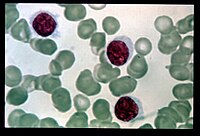
Photo from wikipedia
BACKGROUND AIMS Corticosteroids are the standard first-line treatment for acute graft-versus-host disease (aGVHD), but they are associated with many complications, and less than half of patients have a sustained response.… Click to show full abstract
BACKGROUND AIMS Corticosteroids are the standard first-line treatment for acute graft-versus-host disease (aGVHD), but they are associated with many complications, and less than half of patients have a sustained response. METHODS To improve outcomes, we performed a retrospective study to analyze the efficacy of the addition of extracorporeal photopheresis (ECP) to low-dose corticosteroids in 37 adult patients (median age, 57 years) with skin-predominant aGVHD (grade I, n = 17; grade II, n = 18; and grade III, n = 2). All patients received ECP in combination with 1 mg/kg prednisone (n = 26) or topical steroids (n = 11). RESULTS Overall response rate was 81% after a median of three ECP procedures (range, 2-8), including 22 complete responses (CR, 59%) and eight very good partial responses (VGPR, 22%). The 11 patients treated with topical corticosteroids achieved CR. Furthermore, 16 (62%) patients reached prednisone withdrawal at a median of 100 days (range, 42-174 days) after its initiation. Eighteen patients developed chronic GVHD (cGVHD); 11 of them (who were in CR of aGVHD) had a new-onset cGVHD, and seven experienced progressive cGVHD (five non-responding and two VGPR patients). A second-line immunosuppressive treatment was initiated in only five (14%) non-responding patients. With a median follow-up of 31 months (range, 6-57 months) 2-year overall survival and non-relapse mortality were 74% and 11%, respectively. CONCLUSIONS Overall, the combination of low-dose corticosteroids and ECP appear to be safe and effective for first-line treatment of skin predominant aGVHD.
Journal Title: Cytotherapy
Year Published: 2020
Link to full text (if available)
Share on Social Media: Sign Up to like & get
recommendations!